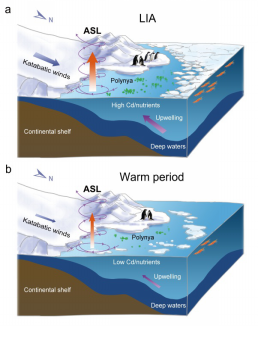Understanding the mechanisms for Southern Ocean ecosystem responses to climate variability is challenging, and up to now there has been little research on the coupling of atmospheric circulation, ocean conditions, and Antarctic marine ecology over geologic time scale.
The study analyzed geochemical records in ornithogenic sediments from Cape Bird, Ross Island. Phosphorus (P) is used to reconstruct historic changes of Adélie penguin populations and cadmium (Cd) is used as a proxy for ocean upwelling intensity. Stable nitrogen isotopes (δ15N) in penguin feathers were used to infer penguin dietary changes for the past 500 years. It is proposed that the linkage between atmospheric circulation, oceanic conditions, phytoplankton, krill and penguins is closer, especially during the Little Ice Age (LIA; 1500–1850 AD). During LIA , a deepened Amundsen Sea Low (ASL) led to stronger winds, intensified ocean upwelling, enlarged Ross Sea and McMurdo Sound polynyas, and thus higher food abundance and larger penguin populations on Ross Island.

Figure 1: Effects of large-scale atmospheric forcing on oceanic conditions and marine ecological processes in the Ross Sea. (a) LIA (∼1600–1825 AD). (b) Warm period (since ∼1825 AD).
Image by YANG Lianjiao
The driving mechanism of marine ecological environmental change that integrates Antarctic marine ecology with atmospheric/oceanic dynamics will be a new field of study which is likely to help explain and predict responses of Antarctic high-latitude ecosystems to changes in atmosphere and ocean. Notably it is another article published in Earth and Planetary Science Letters focusing on the ecological climate change mechanism in Chinese history that marks a new research field of the integration of ecogeology and atmospheric and oceanic dynamics explored by of Anhui Key Laboratory of Polar Environment and Global Change.
YANG Lianjiao, a PhD candidate from the School of Earth and Space Sciences, is the first author of the article. Professor SUN Liguang, Professor Steven D. Emslie and Professor XIE Zhouqing are the corresponding authors. This study was funded by the Chinese Polar Environment Comprehensive Investigation & Assessment Programmes and the International Cooperation in Polar Research and the External Cooperation Program of BIC, CAS. Samples were provided by the Polar Sediment Repository of Polar Research Institute of China.
The study has been published in Earth and Planetary Science Letters, see more at
https://www.sciencedirect.com/science/article/pii/S0012821X17305952.
Contact:
Prof. SUN Liguang
Institute of Polar Environment of University of Science and Technology of China
E-mail: slg@ustc.edu.cn